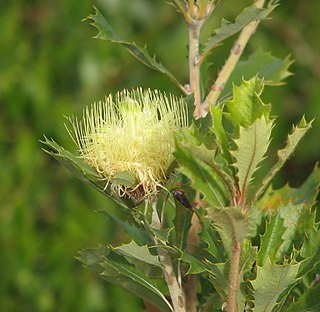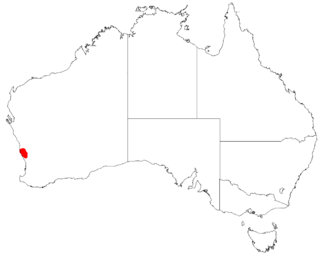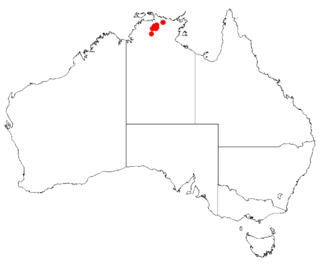
Hakea archaeoides is a large shrub or small tree commonly known as Big Nellie hakea and is endemic to forest areas on the north coast of New South Wales, Australia. It has clusters of red and greenish yellow flowers in the flowering season.

Banksia anatona, commonly known as the cactus dryandra, is a flowering plant in the family, Proteaceae and is endemic to Western Australia. It is a tall, spindly shrub with unusually large fruiting follicles. It is only known from a single location and has been classified as Critically Endangered nationally under the Environment Protection and Biodiversity Conservation Act 1999. The only known population is in danger of extinction from dieback disease.

Alyogyne hakeifolia is a species of flowering plant in the Malvaceae family. It is endemic to the southern regions of Australia. The plant is similar to a Hibiscus and was assumed to be part of that genus for many years. It is known to have been cultivated in England since the mid nineteenth century.
Persoonia papillosa is a species of flowering plant in the family Proteaceae and is endemic to a restricted area in the west of Western Australia. It is a small, erect shrub with hairy young branchlets, linear leaves with six prominent parallel veins, and hairy flowers borne in groups of up to twenty on a rachis up to 60 mm (2.4 in) long.

Grevillea raybrownii is a flowering shrub in the family Proteaceae and is endemic to New South Wales. It has divided, pointed leaves and dense clusters of flowers usually at the end of branches.

Eremophila ovata is a flowering plant in the figwort family, Scrophulariaceae and is endemic to the Northern Territory. It is a small, spreading, rounded shrub with hairy branches and leaves and pink or purple flowers which are white inside.
Dasymalla chorisepala is a flowering plant in the mint family Lamiaceae and is endemic to Western Australia and the Northern Territory. It is a small shrub with its branches and leaves densely covered with hairs. The leaves are stalkless, egg-shaped and covered with yellowish hairs while the flowers are small, tube-shaped and white.
Muniria megalophylla is a flowering plant in the mint family Lamiaceae and is endemic to Arnhem Land in the Northern Territory. It is a shrub with its branches and leaves densely covered with a layer of short, greyish, branched hairs and small groups of reddish-pink flowers near the ends of the branches.

Pityrodia lanuginosa is a flowering plant in the mint family Lamiaceae and is endemic to Arnhem Land in the Northern Territory. It is a woolly, spreading shrub with its leaves arranged in four rows and off-white, bell-like flowers with dark purple streaks.

Conostylis angustifolia is a rhizomatous, tufted perennial plant species in the family Haemodoraceae, endemic to the south-west of Western Australia. In September and October it produces yellow flowers in the species' native range.

Conostylis argentea is a rhizomatous, tufted perennial plant species in the family Haemodoraceae, endemic to the south-west of Western Australia. In July and August it produces white to cream flowers in the species' native range.

Scaevola basedowii is an erect multi-stemmed shrub in the family Goodeniaceae, endemic to Western Australia, the Northern Territory and South Australia.

Sida spenceriana is a small plant in the family Malvaceae found in Queensland, the Northern Territory and Western Australia

Boronia xanthastrum is a species of small shrub that is endemic to the Northern Territory. It has yellow, star-like hairs on the young branches, leaves and parts of the flowers, elliptical to lance-shaped leaves and small yellowish green flowers.

Tribulus platypterus, the cork hopbush, is a species of flowering plant in the family Zygophyllaceae, which is endemic to the northwest of Western Australia. It is closely related to Tribulus suberosus.

Harpullia leichhardtii is a tree in the family Sapindaceae, endemic to the Northern Territory.

Dampiera candicans is a plant in the family Goodeniaceae, native to Western Australia and the Northern Territory.

Dampiera dentata is a plant in the family Goodeniaceae, native to Western Australia and the Northern Territory.

Alysicarpus schomburgkii is a species of pea found in Australia, in the Northern Territory, Queensland, and Western Australia. It was first described in 1926 by Anton Schindler from four specimens: two collected at Port Darwin and the others from north Queensland.
Hibbertia cactifolia is a species of flowering plant in the family Dilleniaceae and is endemic to the Arnhem Land escarpment. It is a multi-stemmed shrublet with hairy foliage, oblong to elliptic leaves and yellow flowers arranged singly in leaf axils, with twenty-six to twenty-eight stamens arranged in groups around the two carpels.
















